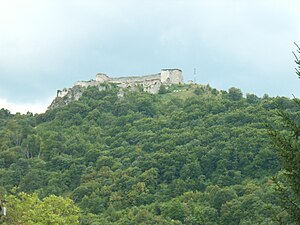| Ostrovica Castle | |
|---|---|
| Ostrovica, Bosnia and Herzegovina Near Kulen Vakuf in Bosnia and Herzegovina | |
 Ostrovica Castle | |
 | |
| Coordinates | 44°33′29″N 16°04′52″E / 44.558°N 16.081°E |
| Type | Hilltop castle |
| Site information | |
| Controlled by | Hranić-Kosača, Disislavić noble family, Kurjaković noble family (later renamed Karlović), Juraj Mikulčić, Ivan Keglević, Frankopan noble family, Kulenović noble family |
| Condition | damaged, partially renovated |
| Site history | |
| Built | 15th century |
| Built by | (unknown) |
| Materials | hewn stone (ashlar) |
| Designations | |
| Official name | Ostrovica – Ostrovački fort, the historic site |
| Type | Category II monument |
| Criteria | A, B, D i., E iii., F ii.iii., G v., I iii. |
| Designated | 4 June 2012 (?th session No. 05.1-2.3-73/12-15) |
| Part of | Una National Park |
| Reference no. | 3387 |
| State | National Monuments of Bosnia and Herzegovina |
| Site is protected as National Monument of Bosnia and Herzegovina by the Government of BiH and its KONS | |

The Ostrovica Castle (Bosnian: Stari grad Ostrovica, Ottoman Turkish: Ostroviçe kalesi) is a large medieval structure situated above the small village of Ostrovica near Kulen Vakuf, Bihać municipality, Bosnia and Herzegovina. Having been built on a heavily wooded ridge of a steep hill overlooking left bank of the shallow Una river, the castle was located on a strategic site connecting the northern and southern parts of the long Una valley.
The modern-day castle was most probably built during the 15th century on the foundations of ancient fortification which dates back to ancient Roman times or even earlier. In the Middle Ages, Ostrovica belonged to the Kingdom of Croatia and its Lapac County.
The first mention of the castle was in a charter from 1407, in which King Ladislaus of Naples, confirmed possession over Ostrovica to a Bosnian magnate and Grand Duke, Sandalj Hranić, who most likely rebuilt the fortress at the beginning of 15th century on a foundations of an ancient fortification, which dates back to ancient Roman times or even earlier. In 1523 it was conquered by the Ottomans.
